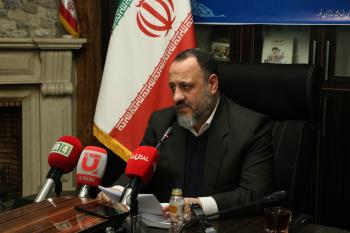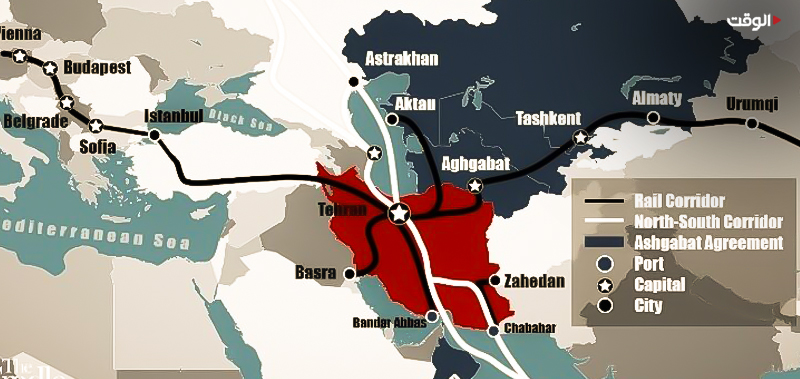Alwaght- While the Ukraine war has brought grave consequences to the global economy, it also made opportunities for some countries to activate their capacities to improve their economic position. One of these opportunities for Iran and other regional states is acceleration of the North-South Corridor that was initiated years ago. Although due to some problems in the way of this transit corridor its operation had been postponed, eventually the obstacles were removed and Iran managed to launch this route with the help of its partners.
On Saturday, the Islamic Republic of Iran Shipping Lines (IRISL) started its transportation through the North-South Corridor, dubbed INSTC, for the first time with the first multimodal cargo from Russia to India. According to Dariush Jamali, the head of the Iranian-Russian port of Salyanka, these shipments were transported on a station-by-station basis in the past, but with the efforts of the shipping team, a mechanism has been set to transport containers from Russia to India or East Asia with just one general bill of lading.
Reduction of transportation and customs costs, cutting the time of container stay in the ports, rapid delivery, elimination of the risks of container shipment, issuing valid transportation documents and possible damage payments, acceleration of banking operations, and increase of trade credit are the advantages of general bill of lading.
The first shipment, of two 40-foot long containers carrying wood laminate with 41-ton weight started its test voyage from Russia's Saint Petersburg to Iran through Astarakhan port.
Importance of North-South Corridor
The project, signed by the Iranian, Indian and Russian transport ministers in 2000, is the most important trade link between Asia and Europe that can play an important role in transit. This transit corridor is a kind of bridge connecting European countries with the Indian Ocean and the Persian Gulf states. One of the advantages of this transportation route is that the cost of transporting goods is cheaper 30 percent. It also halves the time it takes to transport Indian goods to Russia via the Suez Canal.
Having in mind that the Central Asian states and also some Persian Gulf states have announced readiness to join the route, the number of its countries of coverage is considerable and so the consumption market is vast. The more countries involved in this project, the greater its impact on the global economy.
This rail and sea corridor can prospectively join the Chinese Road and Belt project, which seeks to revive the ancient Silk Road, as Iran, Russia, and Central Asian countries are part of China's megaproject and therefore railway infrastructure development in these countries can contribute to realization of this ambition, especially that after eruption of Ukraine crisis, China tentatively shifted to Central Asia and Caspian Sea to transit its goods to Europe.
Iran's place in North-South Corridor
Due to its geopolitical position, Iran has always been a route of choice for the transit of foreign goods and one of the main stations of the ancient Silk Road. This shows that Iran is advantageous over other countries in the region for transit of goods. With operation of the North-South Corridor, Iran can use this advantage to improve its economic position in the region and internationally.
Iran can use this transit route to relay European goods in the shortest possible time and at a lower cost than other routes to the Indian Ocean and the Persian Gulf. Also, to improve the quality of services, it can boost its railway infrastructure. Proper Iranian railways motivate other countries to transit more goods via Iran, something of great benefits to Tehran.
It is predicted that after full operation of North-South Corridor, Iran can make $20 billion in transit profits annually, something helping it reduce its dependence on oil revenues amid American ban on the sector.
The development of the railway part of the route, in addition to expanding the volume of Russia's trade with Iran and the countries of the region, facilitates shift of Russian-Indian trade route from Black Sea to Iran. Therefore, boost of trade exchange with regional powers to an extent eases the consequences of sanctions against Iran and enhances Tehran's bargaining chip in the face of the West.
The corridor is seeing its importance specifically growing as the West adds to its anti-Russian sanctions. India, for example, specially counts on this route. New Delhi heavily invested in Iran's port of Chabahar, which is part of this route, to facilitate exports.
Beside linking India to Europe via this corridor, Iran can connect Central Asia to the Indian Ocean and the Persian Gulf. Landlocked countries in Central Asia can use the corridor's railway to access the high seas. Over time, Iran's place in the corridor would become known to all.
In addition to Iran, this corridor is also profitable for Russia because the country had to use several sea and rail routes to transport its goods to the Indian Ocean and the Persian Gulf. With the opening of this project, Russia can save on its transit costs.
The current conditions present Iran with a proper opportunity to play a bold role in broader implementation of the North-South Corridor and transform into a regional trade hub by developing its rail and transit infrastructure. Given the lower costs and shorter time of trade via this route, Iran can become the main trade link between Asia and Europe and effectively foil the US measures to isolate it from the regional economic projects.



























